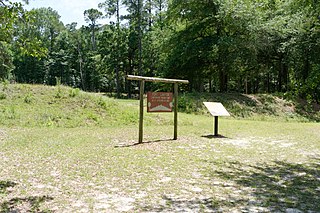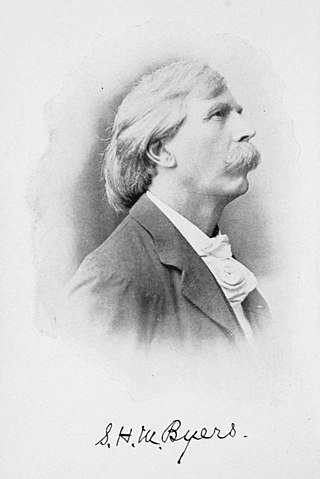
A prisoner of war (POW) is a person who is held captive by a belligerent power during or immediately after an armed conflict. The earliest recorded usage of the phrase "prisoner of war" dates back to 1610.

Sherman's March to the Sea was a military campaign of the American Civil War conducted through Georgia from November 15 until December 21, 1864, by William Tecumseh Sherman, major general of the Union Army. The campaign began on November 15 with Sherman's troops leaving Atlanta, recently taken by Union forces, and ended with the capture of the port of Savannah on December 21. His forces followed a "scorched earth" policy, destroying military targets as well as industry, infrastructure, and civilian property, disrupting the Confederacy's economy and transportation networks. The operation debilitated the Confederacy and helped lead to its eventual surrender. Sherman's decision to operate deep within enemy territory without supply lines was unusual for its time, and the campaign is regarded by some historians as an early example of modern warfare or total war.

Libby Prison was a Confederate prison at Richmond, Virginia, during the American Civil War. In 1862 it was designated to hold officer prisoners from the Union Army, taking in numbers from the nearby Seven Days battles and other conflicts of the Union's Peninsular campaign to take Richmond and end the war only a year after it had begun. As the conflict wore on the prison gained an infamous reputation for the overcrowded and harsh conditions. Prisoners suffered high mortality from disease and malnutrition. By 1863, one thousand prisoners were crowded into large open rooms on two floors, with open, barred windows leaving them exposed to weather and temperature extremes.

The Andersonville National Historic Site, located near Andersonville, Georgia, preserves the former Andersonville Prison, a Confederate prisoner-of-war camp during the final fourteen months of the American Civil War. Most of the site lies in southwestern Macon County, adjacent to the east side of the town of Andersonville. The site also contains the Andersonville National Cemetery and the National Prisoner of War Museum. The prison was created in February 1864 and served until April 1865.

The Rock Island Arsenal comprises 946 acres and is located on Arsenal Island, originally known as Rock Island, on the Mississippi River between the cities of Davenport, Iowa, and Rock Island, Illinois. It is home to the United States Army First Army Headquarters, and the United States Army Center of Excellence for Additive Manufacturing.

Johnson's Island is a 300-acre (120 ha) island in Sandusky Bay, located on the coast of Lake Erie, 3 miles (4.8 km) from the city of Sandusky, Ohio. It was the site of a prisoner-of-war camp for Confederate officers captured during the American Civil War. Initially, Johnson's Island was the only Union prison camp exclusively for Confederate officers but eventually it held privates, political prisoners, persons sentenced to court martial and spies. Civilians who were arrested as guerrillas, or bushwhackers, were also imprisoned on the island. During its three years of operation, more than 15,000 men were incarcerated there.

The Florence Stockade, also known as The Stockade or the Confederate States Military Prison at Florence, was a Confederate prisoner-of-war camp located on the outskirts of Florence, South Carolina, during the American Civil War. It operated from September 1864 through February 1865; during this time, as many as 18,000 Union soldiers were imprisoned there, about 2,800 of whom died.

Camp Chase was a military staging and training camp established in Columbus, Ohio in May 1861 after the start of the American Civil War. It also included a large Union-operated prison camp for Confederate prisoners during the American Civil War.

Camp Ford was a POW camp near Tyler, Texas, during the American Civil War. It was the largest Confederate-run prison west of the Mississippi.

Elmira Prison was originally a barracks for "Camp Rathbun" or "Camp Chemung", a key muster and training point for the Union Army during the American Civil War, between 1861 and 1864. The 30-acre (120,000 m2) site was selected partially due to its proximity to the Erie Railroad and the Northern Central Railway, which crisscrossed in the midst of the city. The Camp fell into disuse as the war progressed, but its "Barracks #3" was converted into a military prison in the summer of 1864. It was the prison holding the largest number of Confederate POWs. Its capacity was 4,000, but it held 12,000 within one month of opening. A different source says that Camp Rathbun had a capacity of 6,000 recruits, but that it was turned into a prison for 10,000 and the Union Commissary General was given just 10 days to make it happen.

Columbia, the capital city of South Carolina, was an important political and supply center for the Confederate States Army during the American Civil War. Much of the town was destroyed during occupation by Union forces under Major General William T. Sherman during the Carolinas Campaign in the last months of the war. Sherman was accused of having deliberately and needlessly burned the city, which he denied. Modern historians say that multiple causes were responsible.

Liendo Plantation is an historic cotton plantation in Waller County, Texas, United States. Named after its original owner, José Justo Liendo, the plantation was purchased in 1873 by sculptor Elisabet Ney and her husband, physician Edmund Montgomery.
Blackshear Prison was a temporary prisoner of war camp located in Blackshear, Georgia, during the American Civil War.

Camp McClellan is a former Union Army camp in the U.S. state of Iowa that was established in Davenport in August 1861 after the outbreak of the American Civil War. The camp was the training grounds for recruits and a hospital for the wounded. In 1863 it became a prison camp called Camp Kearney for members of the Sioux, or Dakota, tribe that were involved in raids in Minnesota. The camp was decommissioned after the release of the prisoners in 1866.

Between 1861 and 1865, American Civil War prison camps were operated by the Union and the Confederacy to detain over 400,000 captured soldiers. From the start of the Civil War through to 1863 a parole exchange system saw most prisoners of war swapped relatively quickly. However, from 1863 this broke down following the Confederacy's refusal to treat black and white Union prisoners equally, leading to soaring numbers held on both sides.

The Alton Military Prison was a prison located in Alton, Illinois, built in 1833 as the first state penitentiary in Illinois and closed in 1857. During the American Civil War, the prison was reopened in 1862 to accommodate the growing population of Confederate prisoners of war and ceased to be prison at the end of the war in 1865. The prison building was demolished not long after the Civil War. All that remains of the former prison site is a section of ruin wall that is maintained by the State of Illinois as an historic site. The prison site is included in the U.S. National Register of Historic Places.

Camp Lawton or the Millen Prison was a stockade which held Union soldiers who been taken as prisoners-of-war during the American Civil War. Located beside the Augusta and Savannah Railroad right-of-way five miles north of what was then Millen Junction in Burke County, the new prison facility was modeled after Camp Sumter. It opened in October 1864 but had to be evacuated within six weeks, due to the advance of Sherman's army through Georgia. With an area of 42 acres (17 ha) and holding over 10,000 of a planned 40,000 men, it was said to be the largest prison in the world at that time.

Charles J. Stolbrand, was a sergeant in the Swedish artillery who emigrated to the United States, becoming a brigadier general in the Union Army during the Civil War, and a politician in South Carolina after the war.

Samuel Hawkins Marshall Byers was an American soldier and poet who wrote the poem "Sherman's March to the Sea", which was the origin of the eponymous term. Byers served in the 5th Iowa Infantry Regiment. He found success in a post-war writing career, including many poems about his native Iowa—most notably "The Song of Iowa", which was declared as Iowa's state song in 1911.


















